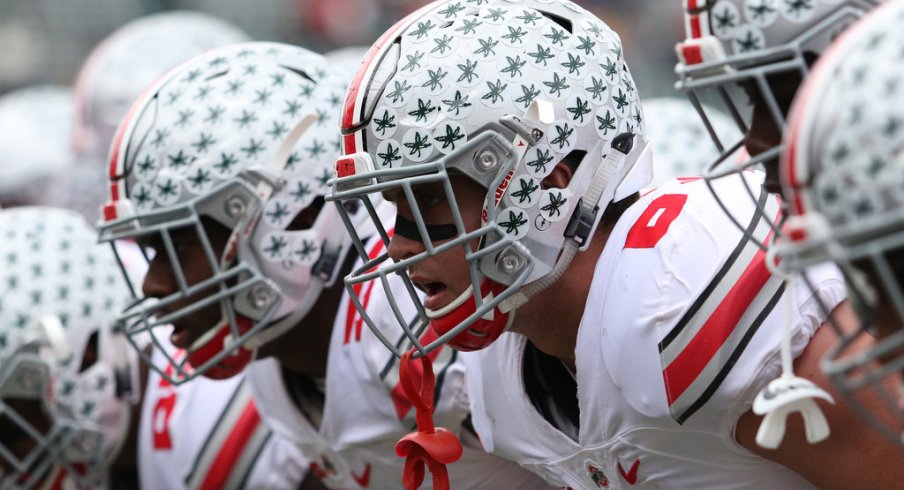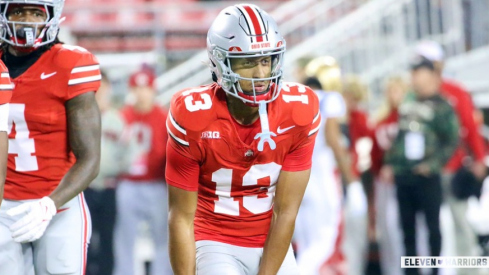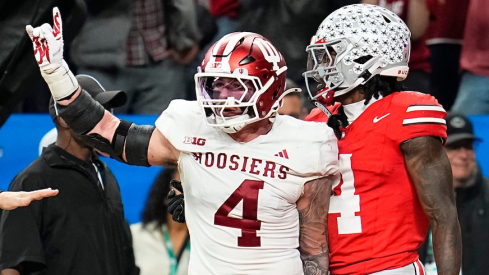Larry Johnson has what we might call a "champagne problem."
While many of his contemporaries are looking to find four, or sometimes just three, players worthy enough to start along a Big Ten defensive line, Johnson has a veritable embarrassment of riches in his meeting room. Not only do the Buckeyes return all four starters up front, including the conference's reigning defensive linemen of the year in Tyquan Lewis, the recruiting efforts of Urban Meyer and the rest of Johnson's colleagues have provided him with the kind of depth rarely seen at the position.
Now, as Ohio State prepares for yet another title chase in the fall, rumors abound about the potential use of five defensive linemen at once, a drastic change for a program that has consistently started only four since the 1980s. With four defensive ends that would start anywhere else in the country in Lewis, Sam Hubbard, Jalyn Holmes, and Nick Bosa along with an emerging star in tackle Dre'Mont Jones, there's enough talent to consider such a drastic change.
Few defenses have regularly featured a true five-man front since the option attacks of the 1970s, responding to the horizontal stretching of the field by offenses. The closest thing to such a look these days is the version of the 3-4 defense played in the NFL by teams like the Pittsburgh Steelers.
For years, the Steelers have drafted defensive tackles to turn into ends, while then turning speed rushing ends into outside linebackers that rush the passer from a 2-point stance. The three down linemen are asked to '2-gap' in this scheme, controlling blockers to close the space on either side, keeping the inside linebackers free to make tackles behind them.
But such a philosophy is difficult to execute, due to the combination of pure size and technical ability needed to pull it off. Few NFL teams even have the patience to find the proper personnel, meaning it's nearly extinct at the college level.
Along the same lines, though, most 3-4 teams are '1-gap' defenses, meaning the linemen and linebackers are all responsible for filling an assigned hole against the run. This is the same philosophy that underlies virtually every 4-3 defense in America, including Ohio State's. The only difference between those 3-4 and 4-3 teams are what they call the ends and outside linebackers, given that their responsibilities are often the same.
In theory, if the Buckeyes were to line up in a straight 5-2 or 3-4 defense with Jones at the nose tackle position and flanked by the four ends and returning starters Chris Worley and Jerome Baker at linebacker behind them, then the most talented seven players would be on the field at once. But not all theories are put into practice.
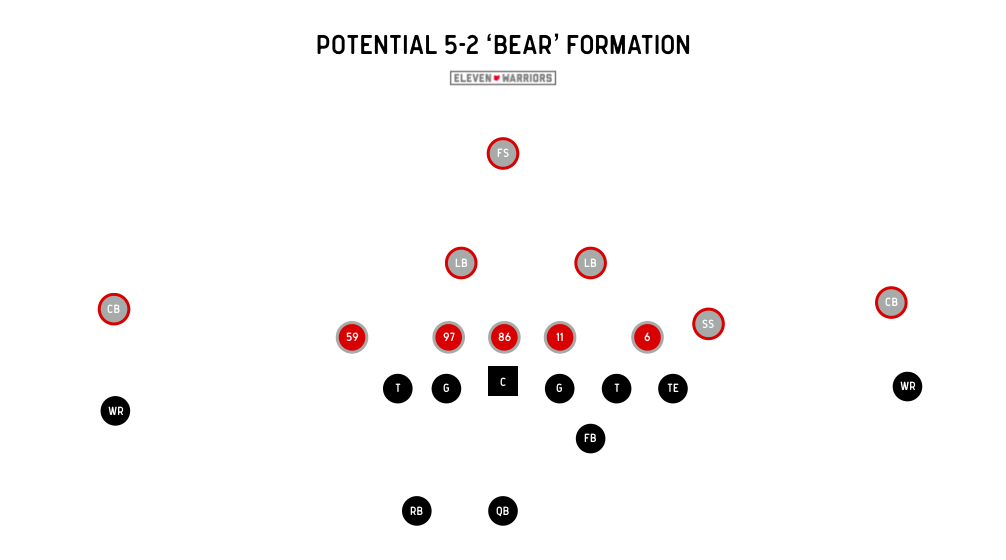
Given that Worley and Baker have less experience playing between the tackles, they could be protected by a 'Bear' look, in which the nose and two tackles line up directly across from the center and guards, creating a logjam inside. Against 2-back offenses, the strong safety could line up like an outside linebacker, providing an extra body against the run, something we saw from the Buckeyes in 2015 against Rutgers and other 'pro-style' teams.
But such an alignment would only be wise against specific personnel. Sure, the defense would terrorize running games, but with essentially only three defensive backs, they'd each be left on an island against the pass. Though coordinator Greg Schiano might've been tempted to pull this trick out of the bag with Marshon Lattimore, Gareon Conley, and Malik Hooker in his huddle, the fact that he didn't with those three at his disposal makes it unlikely we'll see it this fall.
The more likely option against traditional, 2-back offenses like Iowa and Michigan is a variation of the '4-3 Under' in which the SAM linebacker lines up across from the tight end. Sam Hubbard is reportedly practicing from such a spot this spring, making him the most likely candidate to fill the role.
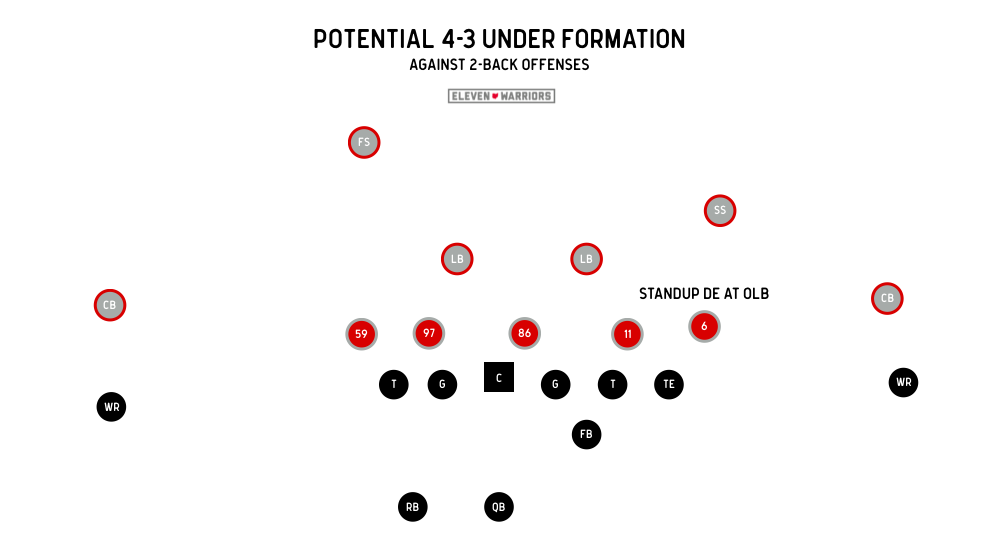
Against the run, nothing changes for the other members of the defense, making Hubbard responsible for setting the edge to his side and turning ball-carriers back inside. However, despite Hubbard's athleticism for someone his size, there's a reason he hasn't lined up at outside linebacker before, meaning the Buckeyes would be limited in what coverages could be called.
Hubbard theoretically matches up best against a releasing fullback or tight end in man coverage, and would likely be lined up to the boundary (short) side, giving him less ground to cover in a zone. From there, the rest of the back seven would have to adjust accordingly, making the entire unit vulnerable to any opposing coordinators worth their salt.
But in both alignments examined thus far, just because all five linemen are on the field at once it doesn't mean they're the best fit for their assigned roles. Jones would likely face a double-team on every play as a nose guard, a far cry from the one-on-one matchups he often sees with a guard as the starting 3-technique tackle. Big space-eaters like Michael Hill are more suited for the spot, hence why he started all 13 games there in 2016.
If we see all five D-line stars on the field together, it will likely come in place of the existing 'Rushmen' package that came in during obvious passing situations last fall and featured the four ends together. With far less proven depth at the linebacker spot, Schiano and Johnson could play a hybrid '5-1-5' nickel package based on the '3-3-5' set we've seen in the past few years.
Here we'd likely see Jones, Bosa, and Lewis as down linemen with Hubbard and Holmes effectively playing linebacker with either Baker or Worley. While the three up front would stay in the same spots every play, the three standing players would have the freedom to move around before the snap, showing blitz combinations in every gap before only rushing one and dropping the others to play a basic, seven-man coverage shell.
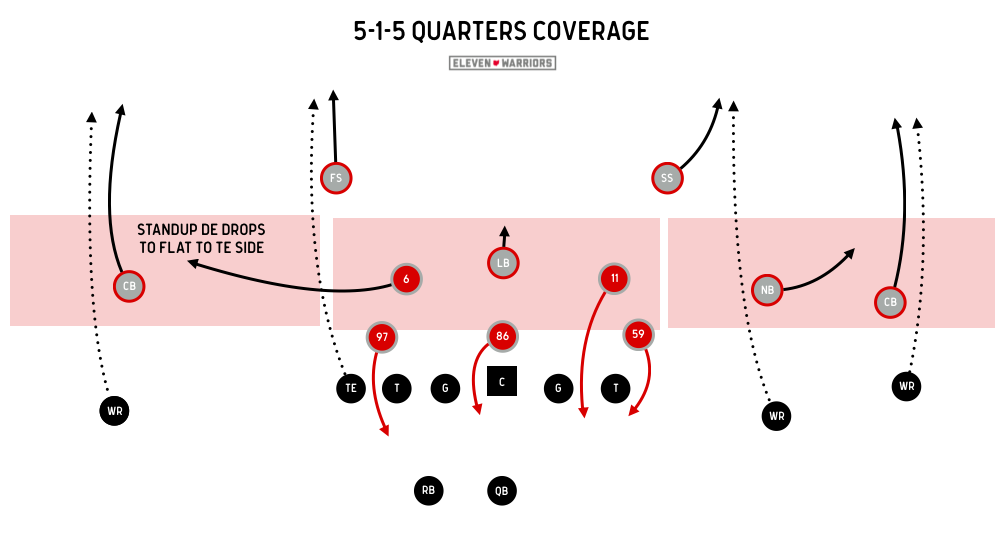
While there may be a coverage liability with one of the standup ends dropping into an underneath zone in coverage, the hope is in a passing situation with five yards or more to gain, Hubbard or Holmes would at least be able to make a tackle before surrendering the first down. Of course, that means that they'd likely have to drop the end to the tight end's side, but an easy strength call before the snap could quickly flip the coverage and rush in either direction.
However, this lineup's best value comes from all five linemen rushing the quarterback at once. Luckily, with five defensive backs and one linebacker, the Buckeyes would have the requisite personnel to pull off a 'zone blitz' with extra pressure coming up front and a six-man zone coverage behind it.
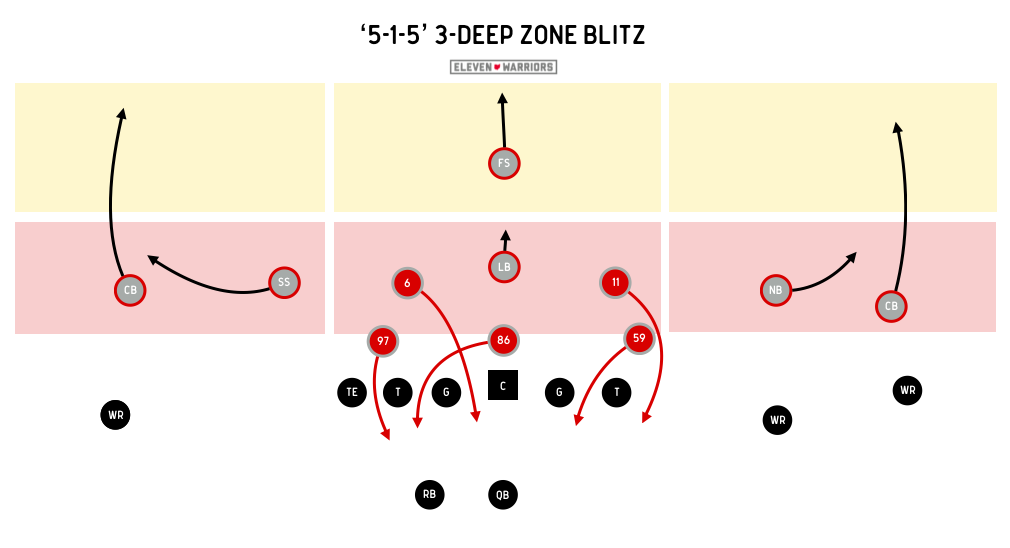
Such pressures are already quite common for the Buckeye defense, although the extra rushers often came in the form of linebackers. Now, all five of Ohio State's best penetrators would be involved, with two of them able to move freely and play games with the offensive line.
As standup rushers, Hubbard and Holmes can give all kinds of false signals to the offense, appearing to line up anywhere from the 'A' gaps over the center to outside the tackles, creating a 'psycho' look similar to what's regularly seen in the NFL from defenses with multiple hybrid defenders.
But much the way the Buckeyes were cautious about employing the 'Rushmen' and 3-3-5 packages last fall, we shouldn't expect a five-man front like this one to be seen very often. At best, the look gives Ohio State the personnel needed to once again become one of the nation's best pass-rushing units. At worst, offenses will tee off on the predictable coverages that come as a result, getting the ball out quickly to the edge before the pressure arrives.
Whatever the decision, Johnson, Schiano, and Meyer have the kind of problem that any other coach in America would happily take on.
